National Library of Australia
When visiting Australia’s capital city Canberra, I urge you to visit to the National Library of Australia in Parkes. The NLA is one of Australia’s best examples of ‘stripped classic’ architecture and as a facility has much to offer visitors.
As far as cities go, I really like Canberra. I find it peculiar that so many Australians speak disparagingly of their carefully-planned national capital when I see much beauty in the city’s architecture, parks and spaces. Maybe that says a lot about my character, I am unsure. I also enjoy visiting Adelaide.
One of my favourite buildings in Canberra is the National Library of Australia (NLA). I really appreciate the elegance of this shiny white library building that rests on the shores of Canberra’s Lake Burley Griffin.

History and Design
The National Library building has recently celebrated its 45th anniversary. Planning started in 1961 when the Sydney firm Bunning & Madden, with associates Tom O’Mahoney and Noel Potter, were appointed as the library’s architects by the Prime Minister, Sir Robert Menzies, who apparently wanted “something with columns” to replace an older structure. The foundation stone for the building was laid by Sir Robert Menzies on 31 March 1966 and the library was officially opened on 15 August 1968 by then Prime Minister John Gorton.
According to images on the NLA website, the current building was intended to be just one part of three. Obviously the expansion plans were never fulfilled but that’s fine because what was built is pretty special.
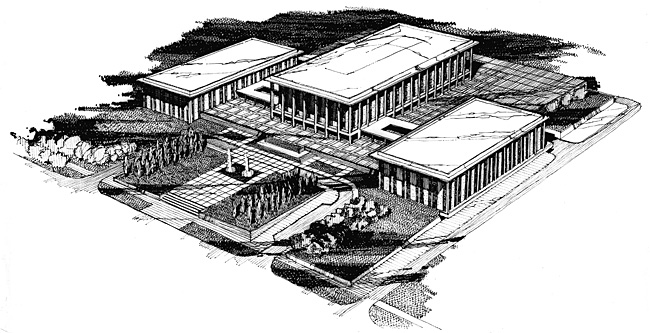
One of the nicest features of the building’s exterior are those columns that Menzies insisted-upon. They’re made of white marble, the same material that clads the walls and fascias. This material gives the building a sense of permanence and endurance which is a good impression for a library to give.
Aside from Menzies’ brief, the inspiration for the building’s design was the Parthenon in Greece. The specific architectural style adopted for the NLA’s design is called “stripped classical“. There are few other significant examples of this style in Australia. One other good example is the Dallas Brooks Hall in Melbourne. Unfortunately the Dallas Brooks Hall has been threatened with demolition, although it remains standing for now.
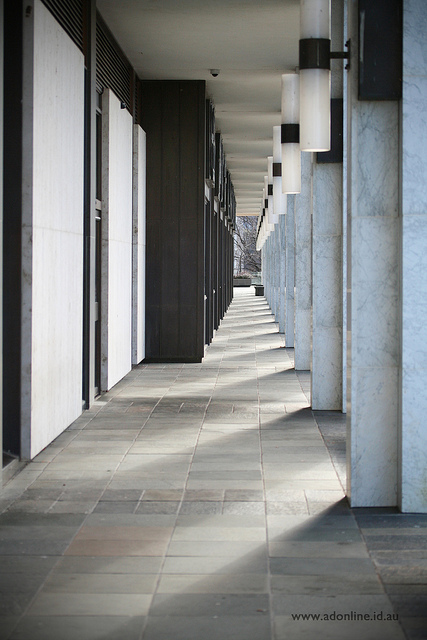
The whole library structure sits upon an elevated platform. On the northern side of the building, this platform opens onto a large balcony which has views of Lake Burley Griffin and the city.
Gardens
The library is surrounded by a garden which, I must admit, is not especially well planted or maintained. In fact, to my eye the gardens in the car park appear almost as a collection of pest species from Victoria, having been filled with Cotoneaster glaucophyllus and Pittosporum undulatum amongst others. The rest of the garden consists of large open lawn spaces with simple plantings of conifers around the perimeter and Muehlenbeckia complexa on some of the walls. Despite all of this, I can see the value of a simple garden in not distracting from the grandeur of the building nor obstructing the view of Lake Burley Griffin.
Inside the Library
The library’s interior is modernist in feel. As one enters via the idiosyncratic ‘In’ door, they are greeted by a marble foyer with a bookshop on the left and cafeteria on the right (more on that later). A marble staircase rises on either side of the entrance to the reading room. There is an illuminated waffle ceiling above this space and on the wall above the ‘In’ and ‘Out’ doors rest three tapestries called Three Tapestries by Mathieu Matégot.
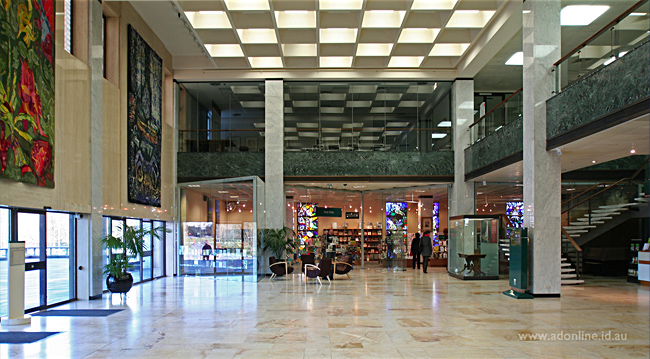
As one enters the building towards the reading room, there’s a security desk and the usual requirement that one deposits large bags and food items for collection later-on. Beyond that is a lovely entrance space to the Reading Room. Although clearly not original (it was refurbished in 2011), the new entrance is in keeping with the general aesthetic of the building and makes good use of complimentary materials including some lovely timbers.

From there, one enters the reading room proper: A large space topped with yet another waffle ceiling. Whilst this interior could never really compete in the minds of many with classical spaces like the Domed Reading Room at the State Library of Victoria, it is nevertheless a wonderfully intact example of mid-60’s modernism. The use of timber panelling, marble columns and mute colours is representative of the era in which the NLA was constructed.
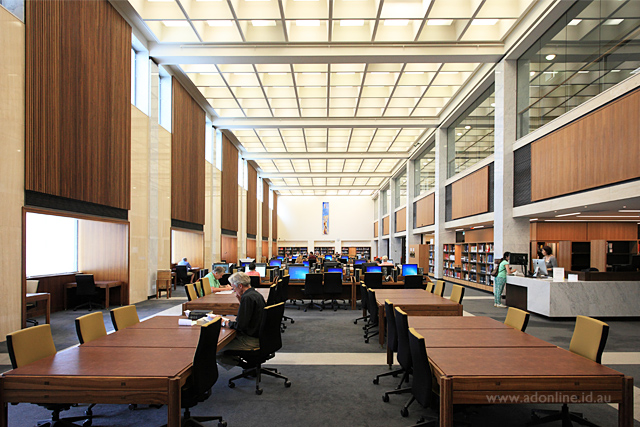
From within the Reading Room one can access computer catalogues, periodicals and a number of smaller study spaces.
If one walks back out of the Reading Room back into the main foyer and proceeds upstairs, there’s an excellent view of the Three Tapestries. Otherwise this serves as an access point for the administrative areas and is mostly off-limits to the public.
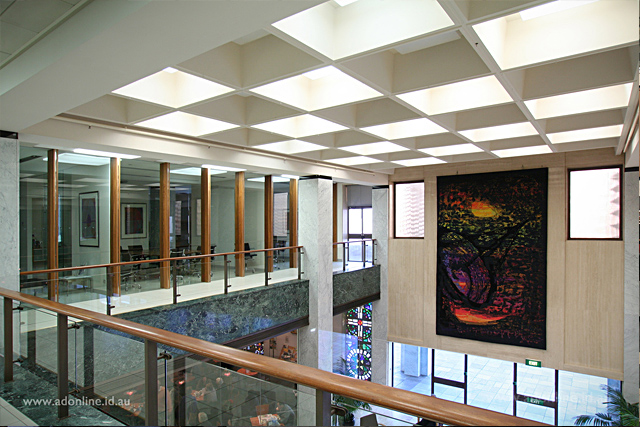
One can also proceed all the way to the bottom of the building into a peculiar study space below the main Reading Room. Aside from providing access to toilets, this space appears to have been transformed into some sort of study space for students. I find this space peculiar with a most unusual atmosphere, in part because the ceiling appears to be made entirely of some sort of lighting diffuser which I imagine was designed to provide continuous even illumination of the space. As can be seen from the image below, this goal isn’t quite met but I can see that from a study perspective, this space is a far more relaxed environment than the Reading Room above.
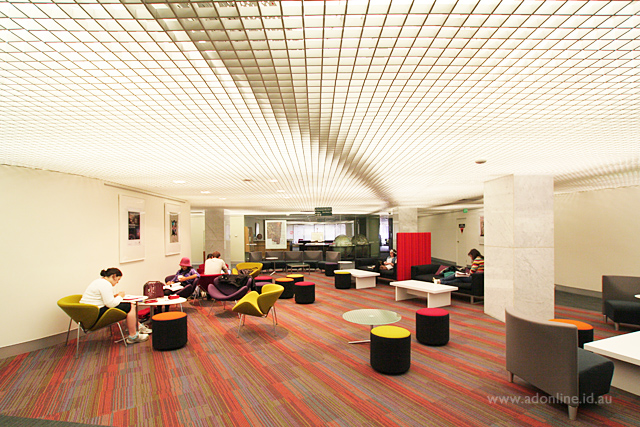
Eating
One of the best discoveries I made at the National Library quite some years ago was the cafeteria. Named Bookplate, this eatery has some truly scrumptious food and excellent coffee. Bookplate is located in the main foyer and can’t be missed literally or figuratively.
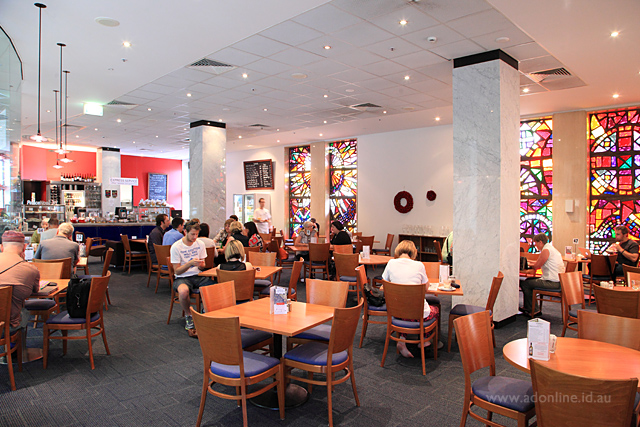
I have variously dined at Bookplate for breakfast, lunch and afternoon tea and would really only recommend the venue for meals after 10am. The range of breakfast options is very limited compared to meals suitable for lunch or morning/afternoon teas. As would be expected in such a venue, prices are a little on the high side but the quality of the food and freshness of ingredients is such that the prices are generally within the range of acceptability. The cakes are especially good.
Whilst eating in Bookplate, one can appreciate the stained-glass windows that were created by Leonard French, the same man responsible for the magnificent stained glass in the Great Hall at the National Gallery of Victoria in Melbourne. These windows provide a wonderful light into the cafeteria for diners to enjoy whilst eating.
Book Shop
The National Library of Australia Bookshop is located on the opposite side of the foyer from Bookplate. It sells a comprehensive range of books, specialising in Australiana, politics, history, cooking and gardening. They also sell a wide range of periodicals and gift items. Good book shops are becoming rare these days, so this one is worth a look.
Use of Cameras
I have been to the National Library several times before and for some reason photography seems to be a bit of an issue with the security guards there. When I took photos of the lower level on a previous visit. I was sternly told-off by an angry security guard for taking photos. When I submitted my camera bag (sans camera) at the security desk on my latest visit, the security guard told me “no photography inside”. No-one ever explained why.
As it turns out, the NLA have a brochure called Use of Cameras (PDF, 429kB) which is available from within the Reading Room (it doesn’t seem to be available on their website). The brochure reads (in part):
You are welcome to use cameras and other personal copying devices in all reading rooms and other public areas of the Library, except in our galleries.
The brochure asks that other requirements be met (such as complying with the Copyright Act, not using a flash and not photographing art exhibits). The library will even provide users with a monopod so that they won’t need to use a tripod in the library! I believe that all of these are entirely reasonable, so as long as these conditions are complied with I don’t really understand what the issue is.
This is a marvellous building which should be celebrated and I believe it would be far more welcoming (and helpful) if the security staff explain what was and wasn’t permitted (as per the policy) rather than falsely suggesting that there’s an outright ban. Aside from people like myself who are interested in photographing the architecture, there would be other users who may want to photograph various library materials (which is permitted).
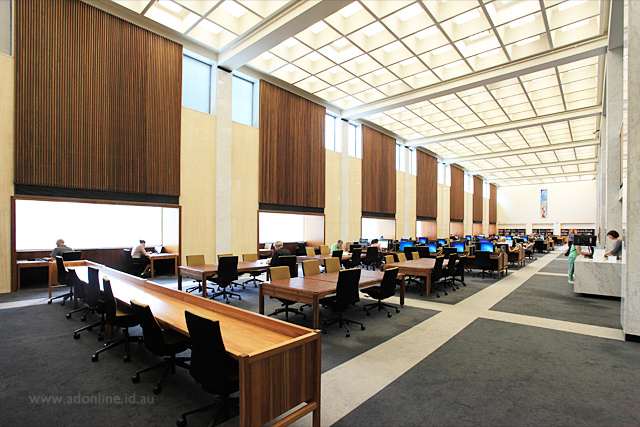
The Library at Night
Finally, I should comment about the elegance of the National Library at night. Situated within the ‘parliamentary triangle‘, the NLA is illuminated after hours and looks absolutely stunning. I took the following photo on my latest visit immediately prior to Christmas 2013:
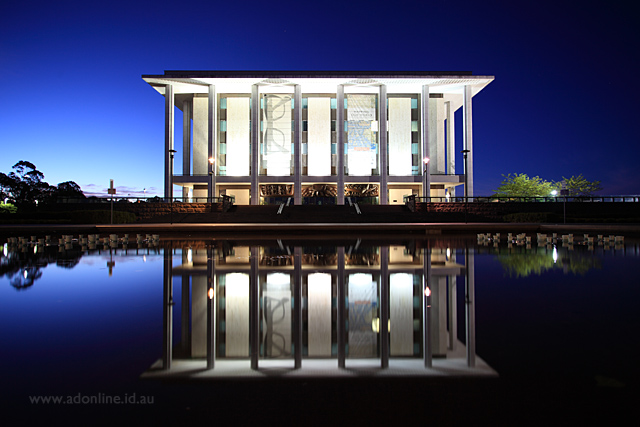
Apparently Canberra hosts a festival called Enlighten Canberra in Late February and March each year. During the festival, the building is illuminated with coloured projections and from what I can see on Flickr, it looks quite impressive.
For Research
I haven’t even spoken about the research facilities at the National Library of Australia!
For researchers, there’s a whole lot on offer but to be honest, I have not used the resources within the NLA building itself. I am a member of the NLA (membership is free and available to all Australian residents) and have used their online resources extensively for private research in the past.
In Conclusion
The National Library of Australia is the nation’s largest library and for those visiting Canberra, well worth a look. Take some time to explore the Reading Rooms, browse the collections and visit the exhibitions in the refurbished gallery (these are not free). Finally, don’t forget to have a snack at the Bookplate cafeteria.
The NLA is open from 9am until 5pm Monday to Saturday with more restricted hours over summer and on Sundays. As one would expect, entry is free.
Comments
One response to “National Library of Australia”
Thanks , I love this building to. I knew Noel potter well, I am one of his granddaughters. This is his work as an architect. He loved books and I have used the resources available inside, a long time ago. I consider it a marvel that more people don’t , glad you enjoy the building. It looks wonderful through your camera.